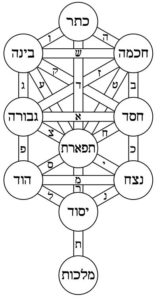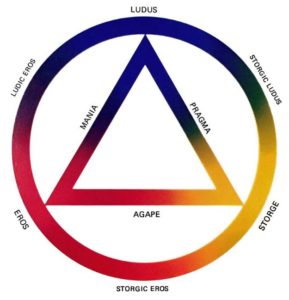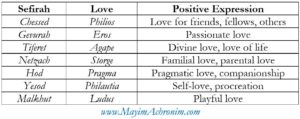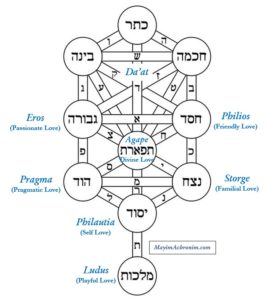In this week’s parasha, Vayera, the word “love” appears for the first time in the Torah. There is a general rule that when a certain term appears for the first time in the Torah, the context in which it appears can teach us the true meaning of that term. Nothing is coincidental, of course, so if a word makes its first appearance in a particular place, this is where to look in order to understand its significance. It is specifically when God puts Abraham to the test that the Torah tells us Abraham loved his son Isaac (Genesis 22:2). There is much we can learn from this.
In the past, we discussed the three general types of love: love for the self, love for another person, and the highest form of love, for God. These correspond, respectively, to the three general categories of mitzvot and Jewish law: bein adam l’atzmo (between a person and himself), bein adam l’chavero (between a person and his fellow), and bein adam l’Makom (between a person and God). Similarly, the ancient Greek philosophers spent a great deal of time thinking about love and spoke of three main forms of love: the “passionate” self-loving eros, the love for another called philios, and the divine love of agape.
 Upon closer inspection, the three general categories of love can be further delineated into seven more specific types. On a Kabbalistic level, the three general categories parallel the three “poles” of the Sefirot: Chessed on the right, Gevurah on the left, and Tiferet in the middle. As is well-known, these three broad energies can be expanded into seven, where below Chessed sits Netzach, below Gevurah sits Hod, and below Tiferet sits Yesod. Under all of them lies Malkhut. (For a brief overview of these terms and their meanings, see here.) These seven lower Sefirot are all associated with the heart, and the key emotional attributes that each person should work on and rectify (whereas the top three Sefirot, the mochin, are associated with the brain and mental faculties). As such, the lower seven Sefirot of the heart parallel the different types of love. Interestingly, the ancient Greek philosophers similarly spoke of a further breakdown of love in seven varieties.
Upon closer inspection, the three general categories of love can be further delineated into seven more specific types. On a Kabbalistic level, the three general categories parallel the three “poles” of the Sefirot: Chessed on the right, Gevurah on the left, and Tiferet in the middle. As is well-known, these three broad energies can be expanded into seven, where below Chessed sits Netzach, below Gevurah sits Hod, and below Tiferet sits Yesod. Under all of them lies Malkhut. (For a brief overview of these terms and their meanings, see here.) These seven lower Sefirot are all associated with the heart, and the key emotional attributes that each person should work on and rectify (whereas the top three Sefirot, the mochin, are associated with the brain and mental faculties). As such, the lower seven Sefirot of the heart parallel the different types of love. Interestingly, the ancient Greek philosophers similarly spoke of a further breakdown of love in seven varieties.
Chessed (“lovingkindness”) represents an unbounded love, positive energy, and endless kindness—including kindness and love for strangers. This is like the Greek philios, which is “virtuous” love and love for others in society, and includes loyalty to friends. (Sometimes, the Greeks had a specific sub-word for hospitality and love for strangers: xenia.) The opposite to Chessed is Gevurah, which is strength and severity, self-restraint and judgement (Din). Whereas Chessed is associated with life-giving water, Gevurah is the burning fire. Gevurah is the passionate flame of eros. Gevurah is an internal quality and is very much tied to both self-love and introspection.
Our Sages teach that Abraham was the paragon of Chessed, while Isaac was the epitome of Gevurah. Indeed, we find that Abraham went out of his way to reach out to people, be hospitable (xenia), take care of others, and “make souls”, while Isaac was mostly in his own world, engaged in deep inner meditation and contemplation, with few disciples aside from his own children. Fittingly, the only time in the Torah we see a mention of “passionate” love (eros) is when Isaac is with his wife! (Genesis 26:8).
Plato explained that true eros is not a physical, animalistic love. Rather, a person is passionate about another because they can see the other’s inner beauty, the spiritual flame burning within them. This is how it was originally in Eden, when Adam and Eve saw each other and recognized each other’s inner glow—as Rabbi Meir taught in the Midrash (Beresheet Rabbah 20:12) that Adam and Eve saw one another’s kotnot or (אור), “garments of light”. Only after the consumption of the Fruit did they lose that ability and saw instead the outward skin, kotnot ‘or (עור, as stated in Genesis 3:21), hence their sudden feeling of shame. Isaac and Rebecca did it right, like Adam and Eve before the Fruit. In fact, this is why the numerical sum of “Isaac” (יצחק) and “Rebecca” (רבקה) is 515, exactly equal to the Torah’s description of Adam and Eve originally becoming “one flesh” (בשר אחד)! This kind of perfect union is the holy manifestation of eros.
Pragma and Storge
The Greek philosophers said that out of eros eventually comes pragma, “pragmatic love”. At the beginning stages of a romantic male-female relationship there is a lot of passion and fire. If the eros remains on a physical surface level only, it will tend to subside after a while. What is left is pragma, which is more of an attachment to the other person and an emotional dependence. It is a love that comes out of mutual understanding, a shared past, and companionship. In the scheme of Sefirot, this is very much the realm of Hod, which sits below Gevurah.
The paragon of Hod was Aaron, and he is famously described as being a person that loved others in an understanding way and always strove to make peace between others. If two people or a married couple were in conflict, Aaron would do whatever he could to bring them back together, without choosing sides and by recognizing that both sides are correct in their own way. He would make each side recognize in the other their shared past, deep affection, and dependence on one another. This is the Hod approach to love.
On the other side is a type of love the Greeks called storge. This is an unconditional love that one has for family members wherein the love is there no matter what, even if there is also a lot of hurt. We overlook the hurt because we have a deep (if not genetic) “blood” bond. This is the kind of love one might have for siblings, parents, and children—ideally, a spouse, too! So, it is like Chessed in the sense that one remains entirely positive and giving, but goes one step further in that it is a type of bond that is unbreakable. This “eternal” love is precisely Netzach, which quite literally means “eternity”, and comes out of Chessed above it.
It is taught that Netzach is the realm of competitiveness and the need to “win” (which is another direct translation of the word netzach). Interestingly, the Greeks saw storge as a love one might also have for their favourite sports team—staying loyal despite frustratingly long losing streaks! Indeed, many sports fan see each other as being part of a wider “family”. Relatedly, Netzach is also the place of strong leadership, which is partly why Moses is described as the epitome of Netzach, being the Torah’s (and perhaps all of history’s) greatest leader. A true leader is able to see the positive qualities in those he leads, and continues to lead them despite the pain and suffering heaped upon him by his followers. Such a leader will always make sacrifices for his beloved people. The Greeks recognized this in an opposite way, where storge is a love not so much from a leader to his followers, but from the followers to their dear leader—even if that leader is a tyrant!
The Right Way to Love
The middle column of Tiferet is most associated with God and truth (and is connected to God’s Ineffable Name; see ‘The Meaning of Tiferet’ here). Tiferet is the central Sefirah, and the only one to intertwine with all the others. This is the Greek divine love of agape. It is not only love for God, and God’s love for us, but also the deepest form of spiritual love one might have for a spouse and a child. Tiferet comes out of proper life balance, and indeed leads to a love of life itself. This is the kind of love King David spoke of when he wrote poetically: “Who is the man that desires life, that loves each day, to see good?” (Psalm 34:13)
Lying directly beneath Tiferet is Yesod, the place of procreation. It is when a couple has that proper, balanced, true love of agape that healthy and successful reproduction (and child-rearing) will result. When expressed negatively, Yesod can became sexual debauchery and immorality, which is equivalent to the Greek philautia, “self-love”. It is associated with ego and self-obsession. The positive manifestation of this type of love is healthy self-esteem and self-compassion, and channeling the sexual urge towards procreation and proper child-rearing.
Finally, at the bottom of the Sefirot is Malkhut, always described as an empty vessel that receives everything flowing from above. It corresponds to the final form of love, called ludus, which is “fun” or playful love, and requires little commitment or permanence. The Romans used ludus to refer to a public spectacle, like a gladiatorial game or circus—something simply for entertainment value. Ludus is empty of anything else. In fact, some warned that it could be dangerous if combined with eros, the result being what the Greeks might call mania.

Canadian psychologist John Alan Lee’s “Colour Wheel of Love” (1973)
However, in its positive expression ludus can bring people together and stimulate those other, higher forms of love. For instance, a married couple might go on a date for a dinner and show—a form of ludus—through which the other forms of love between them will be rekindled. A group of friends or siblings might go to play or watch a sports game as a bonding activity. And so, although ludus, like Malkhut, is in itself “empty”, it is actually important in maintaining the other forms of love, and providing a receptacle for those other loves to flow into.
To summarize:

It is worth pointing out the old suggestion that the word “love” itself may come from the Hebrew le’ehov (לאהב), “to love”! Others say “love” is connected to the Hebrew lev (לב), “heart”. Finally, when the Torah tells us that Adam and Eve united intimately, the word used is yada (ידע)—that Adam “knew” his wife. The Kabbalists state that the seven lower Sefirot of the heart really emerge out of the union of Chokhmah and Binah above, through the interface between them called Da’at, “knowledge”. This may be the deeper meaning behind man “knowing” his wife, implying a complete and total love drawing on all seven forms. Every couple should strive to have ample amounts of all seven forms of love in their relationship, and this is the key to maintaining a happy, healthy, and flourishing, eternal marital union.

The above analysis serves, in part, to synthesize ancient Greek philosophy with even more ancient Jewish mysticism. The purpose is ultimately to better understand the faculties, emotions, and experiences of life. This form of synthesis is without a doubt in line with the views of most of our Sages, who similarly fused together Jewish and Greek ideas in the Midrash and Talmud (where every page is sure to have multiple words of Greek origin!) Some, like Saadia Gaon and the Rambam, went even further in their attempts to fuse Jewish and Greek thought. After all, the Torah long ago stated that the beauty of Yefet should dwell in the tents of Shem (Genesis 9:27)! It isn’t surprising then that the endeavour to synthesize goes back much further, at least to the times of other great Jewish thinkers like Josephus and Philo. This is worth keeping in mind as we near the holiday of Chanukah in the coming weeks and think about the Jewish-Greek relationship. Please also see our three-part series on Jews and Greeks, starting with Part 1 here.
